People around the world III
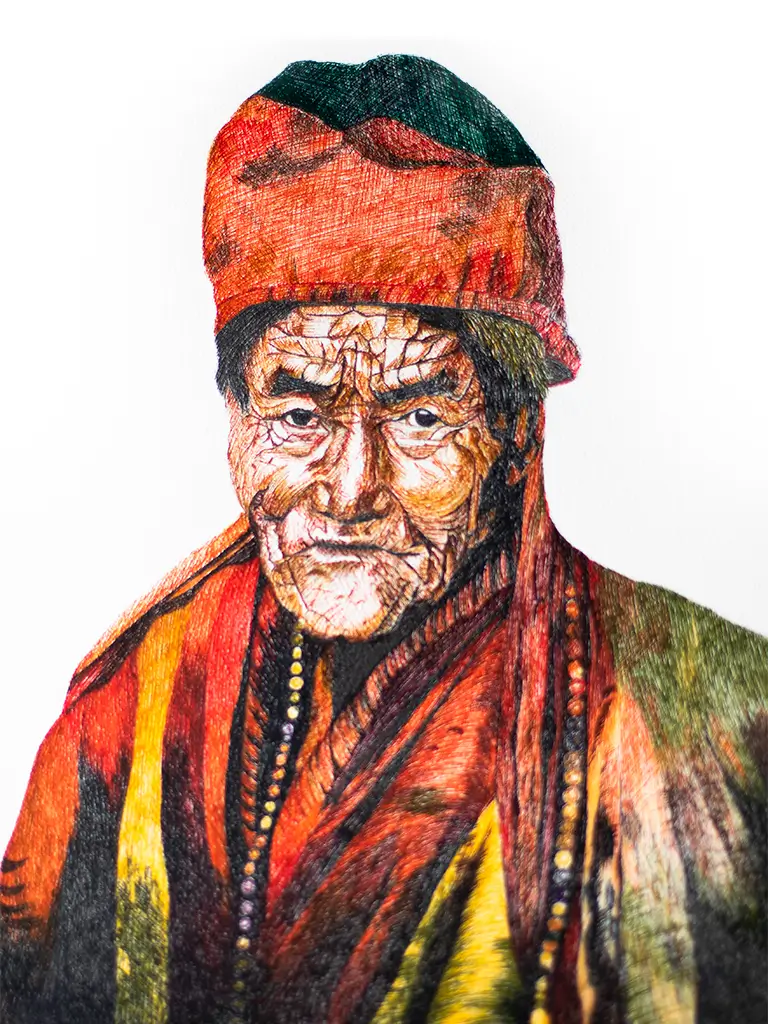
The third portrait in the series shows a woman with a deeply wrinkled face, with the serene dignity of someone who has lived intensely. She wears a voluminous turban and a brightly coloured robe that spills out in rich, expressive folds. A necklace of irregular beads rests on his chest, as if it were just another part of his story. Her appearance suggests South or East Asian roots: India, Thailand, perhaps Mongolia… it doesn’t matter where exactly, but what her face conveys.
The pen stroke, firm and uncorrected, finds in her wrinkles a map of experiences. Each line on the skin is a furrow of time, and each shadow, a story. The colour, vibrant but restrained, gives life to the fabrics, to the brightness of the necklace, to the contrast between the vitality of the outfit and the silent gravity of her expression.
She does not smile or pose. She simply is. She looks straight ahead, with an intensity that does not seek to impose itself, but says it all. Her presence closes the series with a quiet strength, like a root that supports the whole.
Together with the other two portraits – the man with the grey hair and the man in the Arab turban – this figure completes the balance of the series: three faces, three geographies, three different silences, united by the same human gaze.
Pen and colour here become tools of respect, of listening, of attention to the real. It is not a portrait of the exotic, but of the essential.
People around the world I
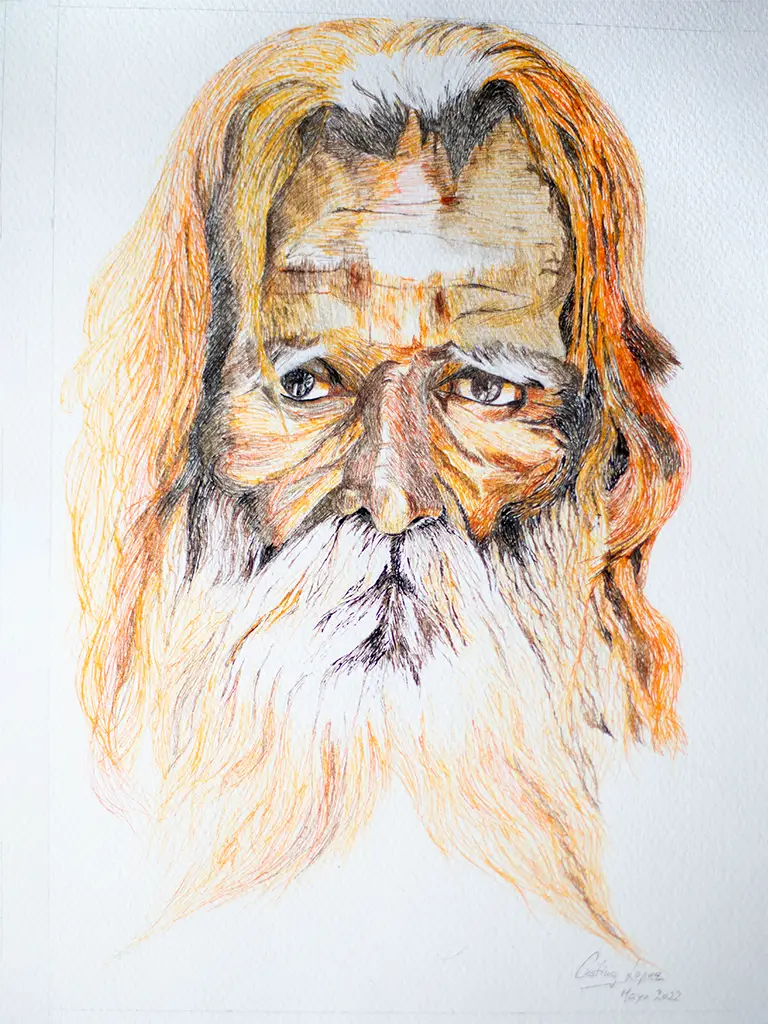
This series of three colour works, executed with biros, is an intimate study of the human in its diversity and depth. Each portrait captures a different face, a particular energy, united by the same technique that combines the immediacy of the pen with the sensitivity of colour applied with restraint and decision.
One of the paintings portrays an Indian man with an intense gaze and abundant, almost wild, grey hair. His hair is not just a physical feature, but a presence, a symbol of identity, of history, of belonging. The pen precisely details the folds of the face, while the colour brings warmth, highlights the contrast between the skin and the hair, and lets the background breathe with a subtly charged atmosphere.
The other two pieces complete the set: different faces, different silences. One perhaps more serene, the other more defiant, but all traversed by the same intention: to capture the invisible. The emotion beneath the surface. The instant suspended between what is seen and what is sensed.
It is not a series about specific characters, but about what they have in common: the imprint of time, the strength of expression, the dignity that emanates from the real. The pen, with its definitive stroke, forces us to look carefully; the colour, with its fragility, reminds us that there is beauty even in the unfinished.
Three paintings. Three faces. A single voice.
Afternoon in Foz
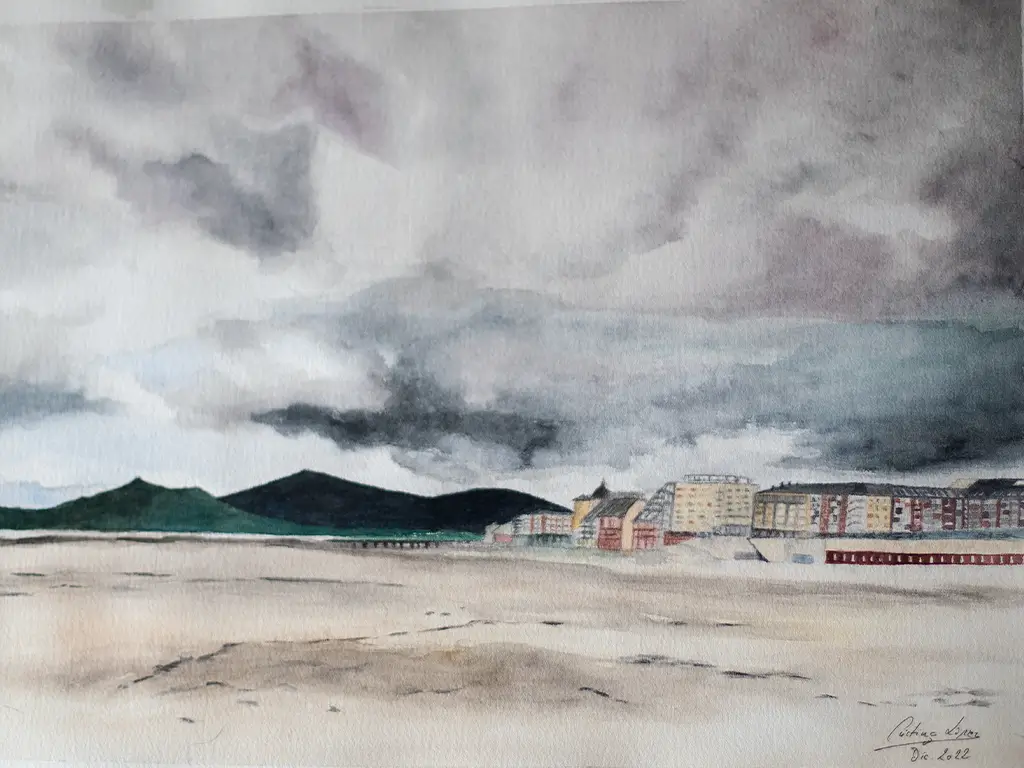
This coastal landscape, executed in watercolour and pen, captures a calm, grey scene on the beach at Foz, Galicia. It is a dull afternoon, one of those that seem to be on the verge of rain, with the sky covered by heavy clouds and the sea very low, exposing the wet sand, dotted with puddles and reflections.
The buildings of the promenade line the background, solid and silent, like motionless witnesses to the passage of time. The watercolour, with its desaturated tones and soft washes, gives shape to the overcast sky and the receding sea. The pen, with its firmer line, defines the contours of the buildings, the lines of the horizon, and some details barely suggested on the coast.
The scene breathes humidity, silence, and a discreet beauty. There is no drama in this dark afternoon, but rather a dense, almost introspective calm, as if the beach were waiting for something: the return of the tide, the light of a new day, or simply the passing of whoever looks at it with attention.
This drawing is a tribute to the Atlantic north, to its restrained light, to the serene melancholy of its coastal villages. A landscape that does not need the sun to move, because in the grey stillness also dwells beauty.
Unknown III
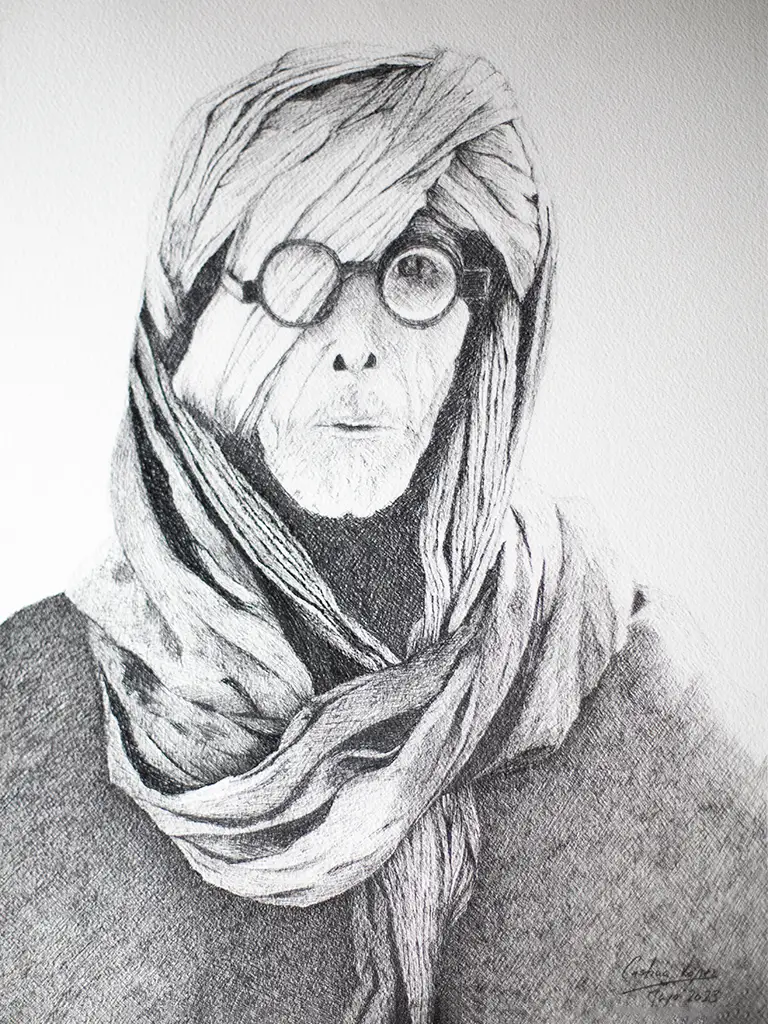
This portrait, painted with marker and pencil – and in some strokes, with biros – depicts the face of an older man wearing glasses and a turban, enveloped in a serene, almost meditative expression. The work, in black and white, renounces colour to focus on the essential: the time inscribed in the folds of the face, the depth of the gaze, the texture of a life.
The technique combines fine lines with areas of shadow constructed from crossed layers. The pen gives a particular density, almost metallic, while the felt-tip pen defines contours and gives weight to the dark areas. The pencil softens, connects, breathes between contrasts. Together, these tools construct not only a figure, but a presence.
The turban, more than an accessory, is a symbol of identity, wisdom and tradition. The glasses frame eyes that look not directly, but inwards, as if they were remembering rather than observing. There is no drama, only dignity.
This drawing is not meant to idealise, but to honour. It is a portrait of humanity, of memory, of roots. Of someone who, although we do not know by name, we feel close to, as if their story – silent, drawn line by line – also spoke a little of our own.
Memories of an afternoon
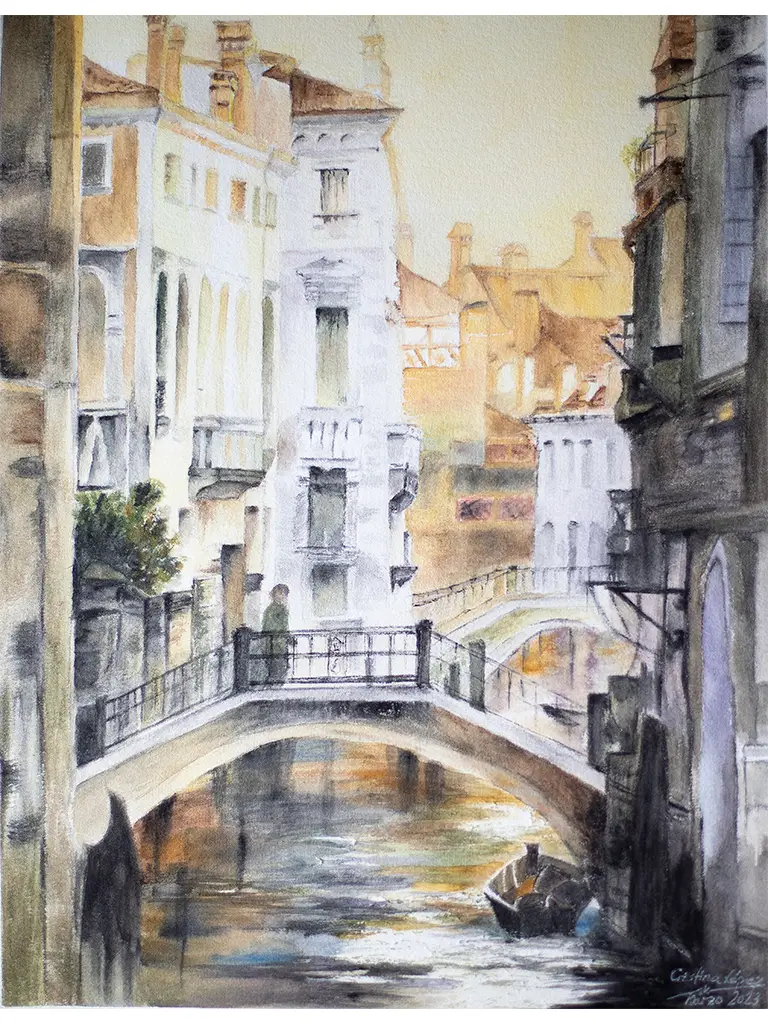
This watercolour painting portrays a European landscape where the river becomes the central thread of the scene, meandering calmly between vegetation-covered banks, small stone houses, and open skies that seem to breathe. The boats float still, moored or drifting, as if resting after a long journey. Some are empty, others barely outline the silhouette of an oarsman, hinting at a story escaping over the horizon.
The watercolour technique allows the water to paint the water: superimposed transparencies, soft reflections, blurred skies in shades of blue, grey and gold. The landscape is not contained, but suggested; there is more emotion than precision. The humidity of the river, the silence of the air, the patina of time on the facades… everything can be guessed in each brushstroke.
Inspired by river scenes from central and northern Europe, this painting seeks to capture not just a place, but a feeling: the melancholic stillness of riverside villages, where life moves to the slow rhythm of the water. In the background, perhaps there is a church or a mill, barely hinted at, as if emerging from an ancient memory.
It is a painting that does not shout, but whispers. A tribute to the quiet beauty of the everyday and the inevitable flow of time.
Hummingbird on flower
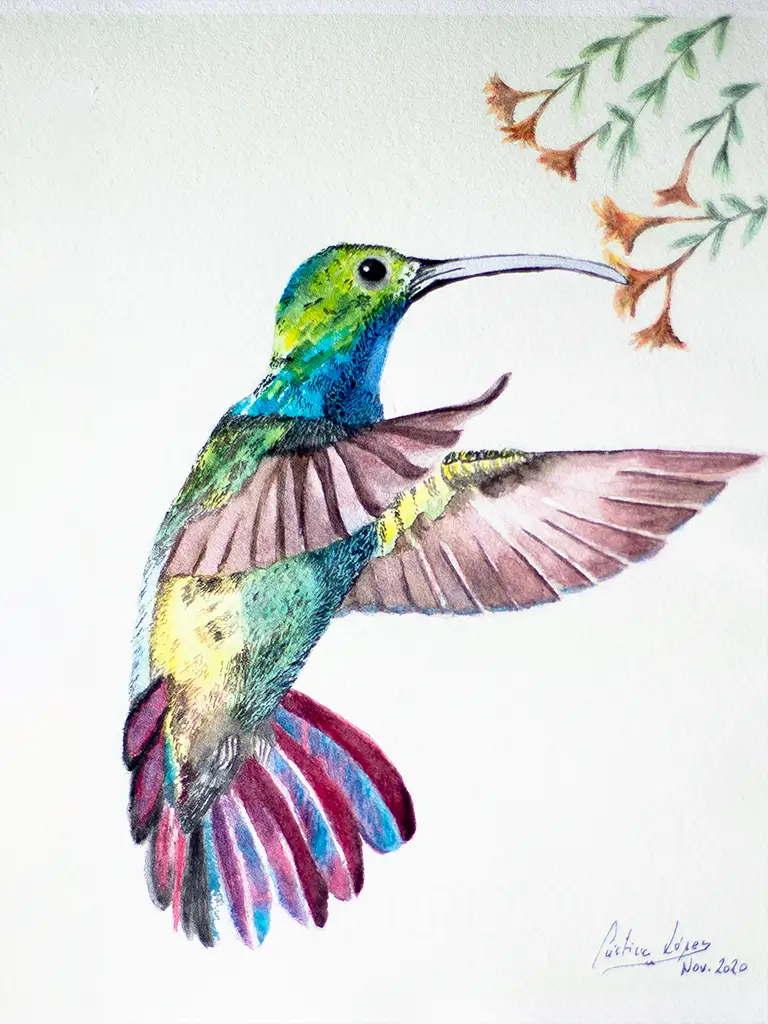
This small drawing captures a fleeting moment: a hummingbird stopped in mid-flight, its beak immersed in a flower. The work is executed in watercolour, ink and coloured marker, a combination that combines the ethereal with the precise. The watercolour brings transparency and movement, evoking the lightness of the air and the speed of fluttering wings. The ink, on the other hand, fixes the structure and gives character to the outline, while the felt-tip pen introduces vibrant, almost electric touches to the feathers and the flower.
Despite its small size, the drawing is full of energy. The hummingbird, a symbol of the ephemeral and the sacred in many cultures, represents here that almost invisible moment that passes before our eyes without our noticing. The gesture of approaching a flower, an everyday occurrence in nature, becomes an almost ceremonial act.
Each stroke was designed so as not to break the delicacy of the moment. The lightness of the water, the speed of the colour, the decisiveness of a line: everything converges to construct not only an image, but a pause.
Because sometimes the smallest thing contains the most intense thing.
Unknown II

This work portrays a young woman wrapped in a white shirt, a simple garment that nevertheless becomes the perfect vehicle for exploring light, transparency and the intimacy of the instant. The technique combines soft pastels and coloured pencil, a mixture that allows for both precise strokes and free gesture, creating a balance between control and spontaneity.
The pastels provide a velvety, almost floating texture that adheres delicately to the paper. The skin tones build layer by layer, revealing the pinks, ochres and lilacs that lie beneath the surface. Coloured pencil is used to accentuate the subtle contours, give definition to the eye and suggest the folds of the shirt, without harshening the overall softness of the drawing.
What lies behind this portrait is not just a female figure, but a restrained atmosphere. She does not look directly, she does not pose, she simply is. The white shirt is not just clothing, it is a symbol of vulnerability, of emotional cleansing, of an intimate moment in which the person is shown without armour.
More than a figure study, this drawing seeks to capture a suspended emotion, as if time has stopped for a second before something changes.